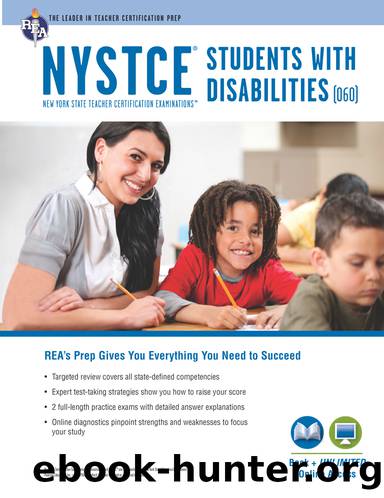NYSTCE Students with Disabilities (060) Book + Online by Springer Ken;Baillargeon Ann Monroe;Chamblin Michelle;Chamblin Michelle;

Author:Springer, Ken;Baillargeon, Ann Monroe;Chamblin, Michelle;Chamblin, Michelle;
Language: eng
Format: epub
Publisher: Research & Education Association
Published: 2016-08-15T00:00:00+00:00
Writing
An effective approach to literacy instruction will always provide students with opportunities to read and write, as the development of reading and writing are intertwined and support each other. This section touches on explicit, systematic instruction in writing that focuses on four areas: mechanics, orthography, content, and process.
Mechanics
The mechanics of writing include the coordinated physical actions required to create text. During the early stages of writing instruction, students learn the following skills:
â¢good posture
â¢proper location of paper
â¢correct pencil grip
â¢letter formation
Orthography
As noted in Chapter 3, orthography is the representation of oral language by means of writing. Through instruction in writing, students learn orthographic rules in the following areas:
â¢orientation of text
â¢spelling
â¢capitalization
â¢punctuation
Content
The content of writing becomes important as students learn about the characteristics of difference genres and the importance of considering oneâs audience and purpose when creating a text. Elements of content that become increasingly important in writing instruction are the following:
â¢word choice
â¢sentence and paragraph construction
â¢organization
â¢clarity
Process
Writing instruction considers not only the form and content of a text but also the process by which it is written. Students learn about each of the following stages in the creation of a final written product:
â¢planning
â¢drafting
â¢editing
â¢revising
Writing Instruction
Effective writing instruction includes the following elements:
â¢explicit, systematic instruction in necessary skills
â¢opportunities to engage in meaningful writing
â¢instruction in the use of technology for writing
â¢integration of writing activities with content instruction
Attitudes and Literacy
It is important for teachers to not only promote reading and writing but to also foster a positive attitude toward literacy and an appreciation of written expression among their students. When a student seems reluctant to read and/or write, the teacher should consider the source of the studentâs reluctance. The following are some of the many possibilities:
â¢The student has poor literacy skills, or a disability specifically related to reading or writing, so that engaging in these activities is a perpetual struggle.
â¢The student has a visual impairment, or some other problem that is not specific to literacy, but which makes the experience of reading or writing difficult and unpleasant.
â¢The student has low self-confidence, or low self-efficacy with respect to reading or writing, so that the student believes he/she will not make progress in these areas.
â¢The student thinks of literacy activities as compulsory and class-specific, and is not aware yet that reading can be informative and rewarding, or that writing can be a satisfying and useful form of expression.
PI (g): Evidence-based explicit and systematic instruction and intervention in mathematics for students with disabilities
This section touches on some of the instructional methods that have been shown to be most effective for teaching mathematics and supporting the integration of math across the general education curriculum.
Download
This site does not store any files on its server. We only index and link to content provided by other sites. Please contact the content providers to delete copyright contents if any and email us, we'll remove relevant links or contents immediately.
1,001 ASVAB Practice Questions For Dummies by Powers Rod(4328)
ASVAB For Dummies by Powers Rod(2695)
Police Exams Prep 2018-2019 by Kaplan Test Prep(2335)
Churchill by Paul Johnson(2331)
Wonder by R J Palacio(1964)
Wiley CPA Examination Review Focus Notes by Kevin Stevens(1808)
1936941139 (N) by Bob Rosenthal(1734)
First Aid Handbook--Crucial Survival Skills, Emergency Procedures & Lifesaving Medical Information by Department of the Army(1706)
A Very Stable Genius by Philip Rucker & Carol Leonnig(1548)
ASVAB AFQT For Dummies by Rod Powers(1541)
1,001 ASVAB AFQT Practice Questions For Dummies by Angie Papple Johnston(1376)
U.S. Army Combat Pistol Training Handbook by Army(1369)
CISSP For Dummies by Miller Gregory Peter(1360)
Future Design by Unknown(1355)
The GED Crash Course by Alpha(1326)
McGraw-Hill Education 2,000 Review Questions for the CPA Exam by Denise M. Stefano(1272)
Master the Civil Service Exams by Peterson's(1266)
Court Officer Exam by Learning Express LLC(1257)
Master the ASVAB by Scott Ostrow(1245)
